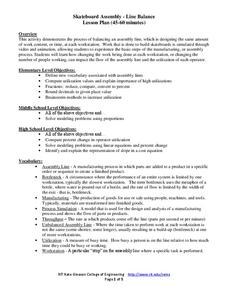Curated OER
Funny Business
Students discuss how much they understand of satire and parody. They read an article about an Iraq news parody show. They create and act out their own parody skit. They write an essay about using humor in grave situations.
Curated OER
Buying New Stuff
Young spenders take a look at the best ways to save and spend money. This type of financial education is lacking in schools, so implementing this lesson would be of great value to your students. Things like bank checking account fees,...
Curated OER
Jack of All Tails
After reading the book Jack of All Tails, learners complete vocabulary activities, play charades, consider a list of questions, and complete a list of verbs. There are also several suggestions for how to connect this language arts lesson...
Curated OER
Mark Twain Lesson Plans
Celebrate the birthday of Mark Twain and learn about American life and literature along the great Mississippi River.
Curated OER
Food Production and Services
Students explore the Family, Career and Community Leaders of America (FCCLA). In this FCCLA lesson, students research and design food-related businesses. Students create business plans and present them to their classmates.
Curated OER
Sources of Finance
Students determine the difference between internal and external sources of finance. They justify their judgment decisions and how they sources their businesses.
Curated OER
Supply Chain Management
Students identify the steps of production. In this supply chain lesson, students determine how businesses monitor production and trace the supply chain of products they own. Students also discuss ethical issues related to the supply chain.
Curated OER
ADULT ESOL LESSON PLAN--Level 5--Time and Money
Students, after defining and reviewing the extensive list of vocabulary words on the board, examine various banking systems and terms (loans, interest rates, investments, mortgages, etc.). They also show mastery of this task by...
Rochester Institute of Technology
Skateboard Assembly - Line Balance
Utilize the instructional activity on utilization. The second installment of a nine-part technology/engineering series teaches scholars about the flow of a balanced assembly line and the definition of utilization. Videos, activities, and...
Curated OER
PLANNING A DIVERSIFIED INVESTMENT PORTFOLIO
Twelfth graders research stocks and how to read and interpret financial data. They choose 5 companies to invest in and track their performance over 10 weeks. They create a spreadsheet which shows the results.
Council for Economic Education
New Sense, Inc. vs. Fish 'Till U Drop or Coase Vs. Pigou
Who is responsible for protecting the environment, and who should pay when it is damaged? The role of government and private industry is complicated. A role-play simulation prompts individuals to decide how to protect a fictitious town...
Council for Economic Education
Unemployment Data: Is the Economy Healthy?
The United States will never see a time when the unemployment rate hits 0%. Why? Scholars research economic data to uncover clues hidden in the unemployment rate at any given time. A short video as well as research activities help...
National WWII Museum
What It Takes to Win: Mapping Primary Source Evidence
World War II was not just waged in Europe and Asia; the home front was key to Allied victory. Using newspaper clippings from World War II and a map, scholars plot out wartime production in the United States. After that, class members...
Texas Education Agency (TEA)
Mistake, Misrepresentation, and Fraud
Fraud alert! Scholars conduct research about consumer fraud and create a presentation detailing the information they find. Additionally, they research and write a report about lawsuits that resulted in large settlements.
Nebraska Department of Education
Writing Emails That Matter
LOL! BRB! :-) The rules for business and professional emails differ significantly from online communications among friends. As part of a career readiness study, pupils learn the do's and don'ts of writing professional emails.
EngageNY
Grade 9 ELA Module 4, Unit 1, Lesson 18
As first-year students continue to investigate how sugar changed the world, the focus shifts to a consideration of why people with limited job options take on dangerous or subjugating work. Class members read an opinion piece by Nicholas...
EngageNY
Grade 9 ELA Module 4, Unit 1, Lesson 10
What can consumers do to pressure companies to produce "ethically manufactured goods"? Readers examine the evidence Amy Odell uses in the supplemental text "How Your Addiction to Fast Fashion Kills" to support her argument and her...
Curated OER
Asset Led versus Market Led Marketing
Students make a distinction between asset-led and market-led business approaches. The context used is that of British Airways (BA). BA has faced a number of challenges in the last ten years and the strategies developed have, in some...
Curated OER
Valentine City
Students construct a small city on a table in the classroom. Each student is given a lot to develop. They give directions from one location to another, and write letters with correct addresses to their classmates.
Curated OER
The Kindness Company
Students organize themselves into a simulated company complete with applications, interviews and training. They identify a community need they can fulfill related to cooking or sewing and work to make and deliver the designated product.
Curated OER
Teen Entrepreneurship
Students explore teen entrepreneurs. For this teen entrepreneurship lesson, students examine teen entrepreneurs and answer questions about the real-word situations. Students role play and explore the basic characteristics of an...
Curated OER
Creating and Marketing a Commercial
Students create a marketing video to sell school products.
Curated OER
It's On Sale
First graders read the book The Great Pet Sale to learn about economics and advertisements. For this economics lesson plan, 1st graders read the book The Great Pet Sale and define related vocabulary words. Students compare prices to find...
Curated OER
Our Economic System
Students examine the American economic system. In this economics lesson, students research the organization of American business and determine how business decisions are made.

























